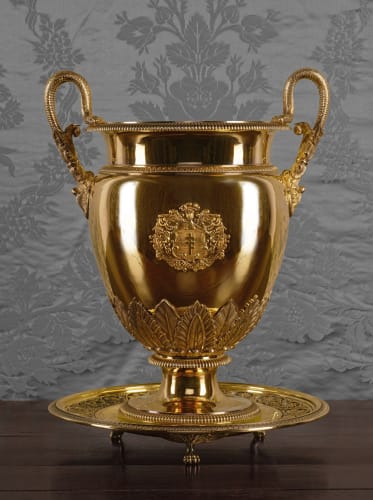JEAN-BAPTISTE-GUSTAVE ODIOT (1823 - 1912). FRENCH
Since the beginning of the Eighteenth Century the Odiot family have distinguished themselves at master silversmiths The best known of this dynasty was Jean-Baptiste-Gustave's grandfather. Jean-Baptiste-Claude Odiot (1763-1850) who created some of the finest Empire silver. Heavily patronised by Napoléon and later Louis XVIII he also furnished services to a number of other European courts. On his retirement, 1827 the business passed to his elder son, Charles-Nicolas (1789-1868) upon whose death the firm was entrusted to his elder son. Jean-Baptiste-Gustave (referred to as Gustave). Charles-Nicolas developed a softer and less austere rendition of his father's Empire style, introducing cherubs, floral swags and flowing vines. His style reflected the renewed interest for the rococo which was to be more fully exploited by his son. Gustave Gustave also applied Louis XVI and Renaissance forms and decorations. Such a variety of styles exemplified the eclecticism during the Second Empire, in addition Gustave often combined more then one style to create a unique design. For example his grandfather developed the Antique motif using a female figure to support a vessel Gustave also used this theme to good effect, but for instance, replaced the Empire sphinx with a cherub. In 1839 he created a centre piece for the Duc l' Aumale (Odiot collection), comprising three cherubs holding a boat shaped vase. In another piece, a silver-gilt tureen of 1880 (private collection) the dish is supported by a semi-draped crouching nude; this tureen was designed by Edouard Récipon. who often collaborated with Gustave.
On occassion Gustave worked with his father and from the 1860's poduced a number of pieces in the Chinese style. The taste for Chinoiserie was immensely popular during the early Eighteenth Century under rococo influence and enjoyed a revival during the mid Nineteenth Century. Charles-Nicolas and Gustave were also influenced by Japan, in particular they imitated Far Eastern Metalwork techniques, sometimes producing a matt finish by the use of acids and decorating their silver with etched floral panels. Gustave produced a fine bougeoir de toilette. In 1883 (Odiot collection), inspired by the French rococo silversmith, Thomas Germain (1673-1748). Here Gustave uses shell-shaped dishes and naturalist asymmetrical stems to create candlesticks. Other pieces by him look back to the Louis XVI style, so favoured by Napoleon Ill's Empress, Eugénie. At the Exposition Universelle, Paris, 1567, Gustave showed a Louis XVI style silver-gilt jardinière, with handles formed of semi-nude classical maidens. At other times Gustave looked back to the Renaissance, for example his design for a silver-gill dessert knife and fork with porcelain handles, 1890 (Odiot collection) is modelled after the Renaissance, though the decoration to the handles is ostensibly Chinese. Interestingly the mixture of materials in cutlery was still relatively new in 1890 and demonstrates Gustave's flair for innovation Gustave was a superb craftsman, appreciated at home and abroad: in 1898 he received an appointment with the Russian court. Today however his name tends to be overshadowed by his grandfather but in the light of an important and recent biography importance has been reassured.
Copyright by Richard Redding Ltd.
